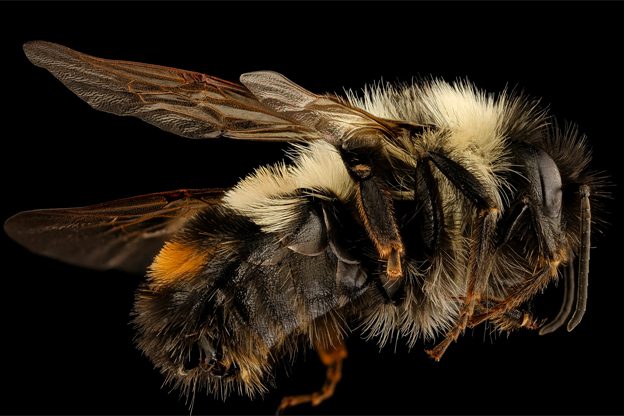
The fate of Bombus affinis is in your hands!
Most of us know about the declining pollinator population and about the peril that honeybees face. Did you know a situation at least as dire applies to native bumblebees?
In January 2017, the rusty patched bumblebee (Bombus affinis) was designated an endangered species. The listing went into effect on March 21, 2017. It is the second native U.S. bee to be listed as such, and the first to be listed in the contiguous United States. (In September 2016 seven species of yellow-faced bees that are native to Hawaii were listed as endangered species.)
Twenty years ago the B. affinis could be seen in 28 to 31 states and was the most common bumblebee around. In the last 20 years its population has plummeted by 87% and its range has diminished by 99.9%. B. affinis is now only spotted in a few (ten or thirteen) states, and it’s been spotted more often in cities than in the country. One of the states where B. affinis is still found is Minnesota. [Minneapolis is apparently a sanctuary city for B. affinis, ed.]
You probably know that the Minnesota state flower is the lady slipper, the Minnesota state bird is the loon, the Minnesota state butterfly is the monarch, the Minnesota state muffin is the blueberry muffin … okay, I’ve exhausted my knowledge on this. And, the Minnesota state bee is the rusty patched bumblebee! Governor Walz designated B. affinis as the Minnesota state bee in May to call attention to its endangered status.
In conjunction with the designation as the state bee, a Minnesota state program is being established which will offset some of the cost for homeowners who decide to convert their lawn to include pollinator-friendly plants.
Greg Stanley writes in the Star Tribune on May 30:
The state will set aside $900,000 over one year to assist homeowners by covering much of the cost of converting traditional lawns by planting wildflowers, clover and native grasses in an effort to slow the collapse of the state’s bee population. The plan was trimmed down from the original House and Senate proposals, which would have provided funding for three years.
The plan could help replenish food sources for pollinators of all kinds, but will specifically aim at saving the rusty patched bumblebee, a fat and fuzzy species on the brink of extinction that seems to be making its final stand in the cities of the Upper Midwest.
The program would cover up to 75% of the cost of each conversion project, and up to 90% in areas with a “high potential” to support rusty patched bees.
Research at the University of Minnesota has shown that bumblebees are particularly important to the region. They land on flowering stems and vibrate at a frequency close to a musical C note, which unlocks pollen other insects can’t reach.
The exact details of the implementation of this program have not been established yet, but it may be available as early as next spring.
Along with vibrating in the note of C, some other interesting characteristics of B. affinis are that they burrow underground and depend on newly produced queens to survive the winter and reestablish a colony. According to the USFWS:
Queens produced in late summer and fall are the only members of the colony to survive winter. After mating, they hibernate a few inches underground in loose soil.
During the late summer and fall:
The males and new queens (gynes, or reproductive females) disperse to mate, and the original founding queen, males, and workers die. The new queens go into diapause (a form of hibernation) over winter. The following spring, the queen, or foundress, searches for suitable nest sites and collects nectar and pollen from flowers to support the production of her eggs, which are fertilized by sperm she has stored since mating the previous fall. She is solely responsible for establishing the colony.
Rusty patched bumblebees are one of the first bee species to emerge in the spring and one of the last to hibernate in the fall. They need flowering plants as pollen sources throughout the season, and undisturbed soil for their colonies and to overwinter.
A Star Tribune article by Val Cunningham from last fall is headlined:
An excuse to leave your garden messy: It’s for the birds
That’s a good enough excuse for me, but now I know it’s for the bees, too!
For a bit more information, check out the Messy Gardening website and the Rusty Patched Bumbelbee Midwest Plant Guide.
Thanks for your feedback. If we like what you have to say, it may appear in a future post of reader reactions.


